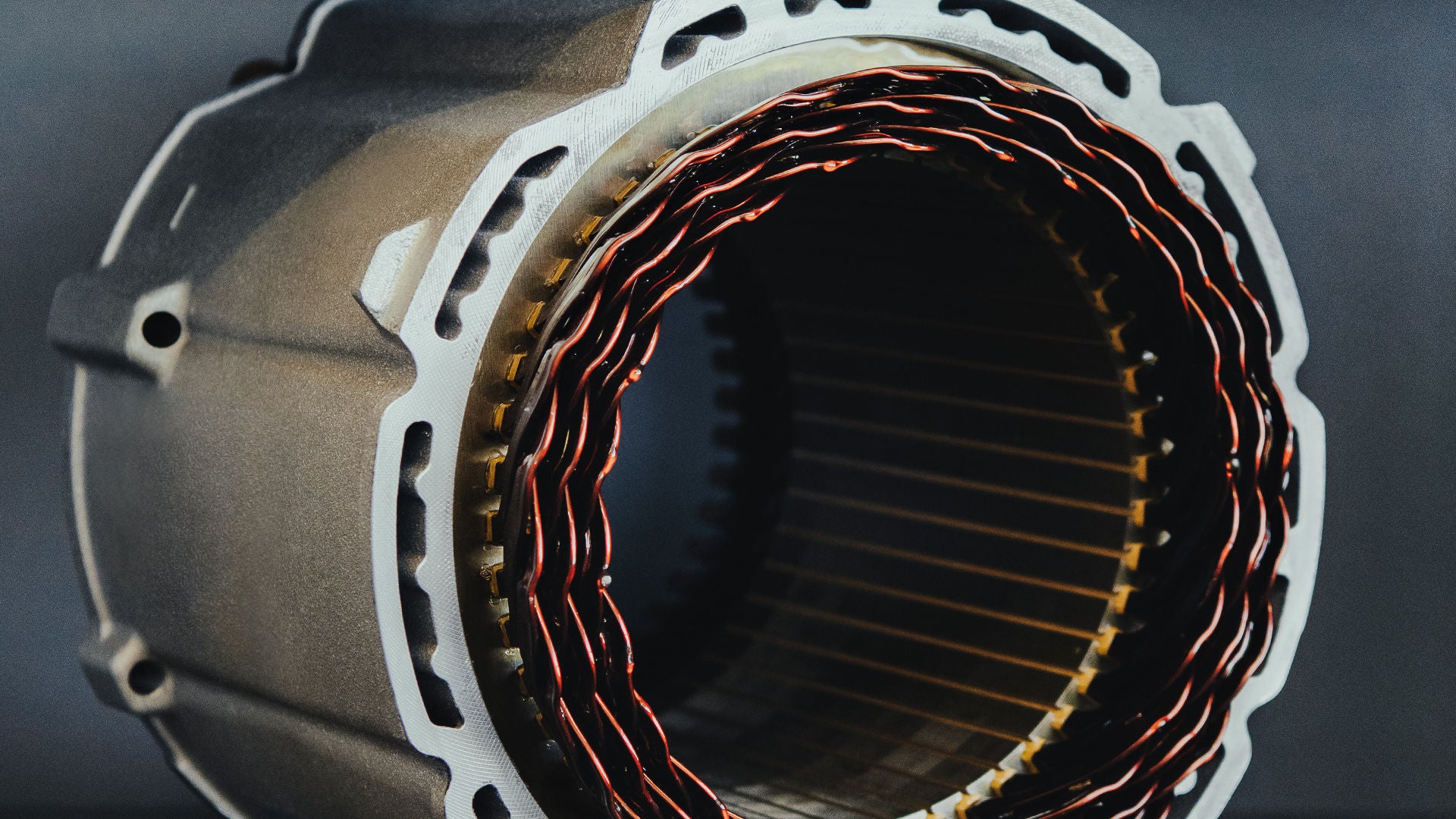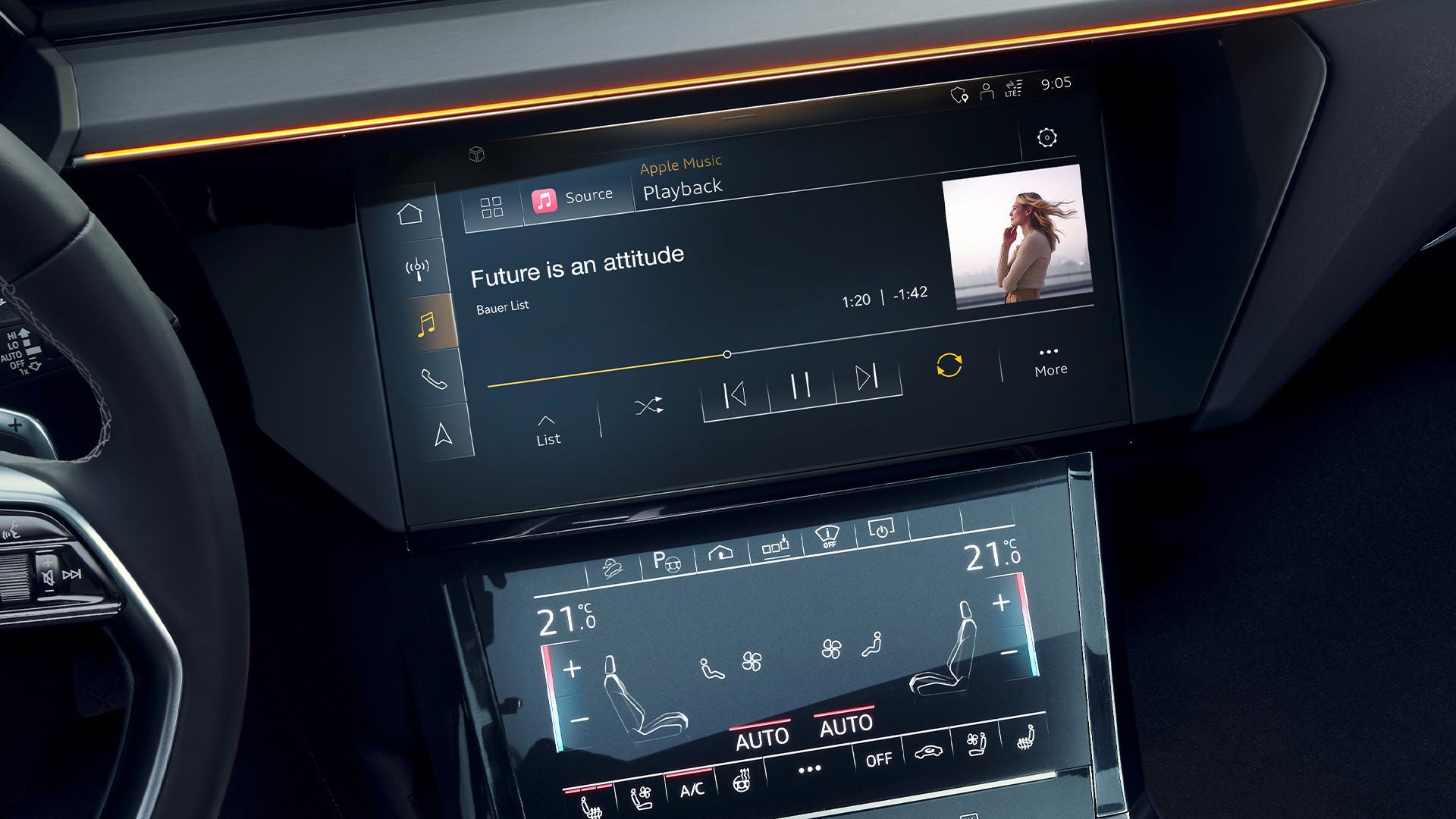Aerodynamics: Scoring decimal points
missing translation: fa.article-intro.reading-time – Report: Bernd Zerelles - Photo: Robert Fischer – 05/04/2023
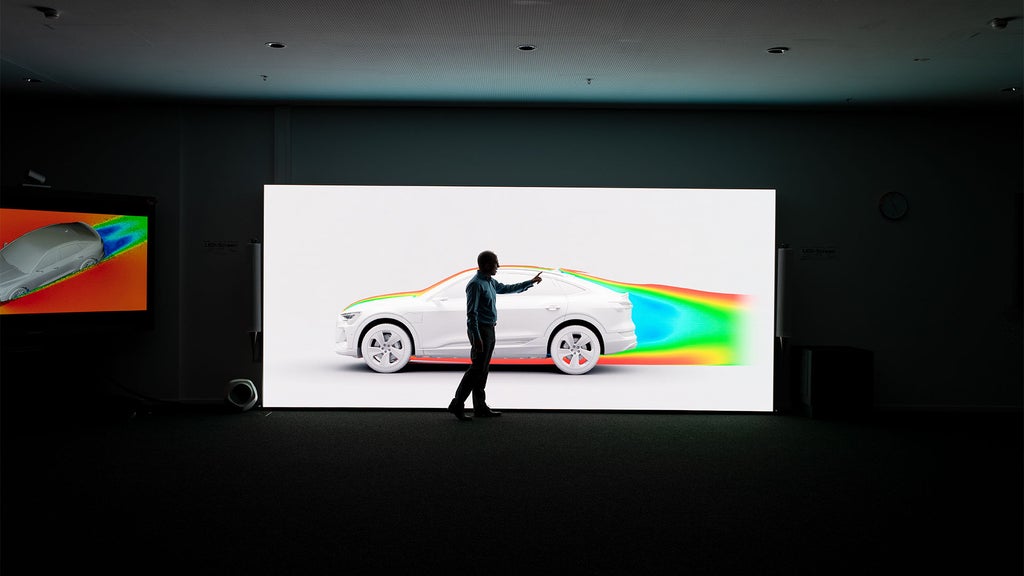
“In the day-to-day driving of electric cars, aerodynamic drag is the chief factor in driving resistance. Even when the Audi e-tron Sportback, for example, is driven in line with a standard cycle as defined by the World Harmonized Light-Duty Vehicles Test Procedure (WLTP), driving resistance is responsible for just over 40 percent of consumption. Compare that to accelerating the vehicle’s weight, which accounts for slightly less than 20 percent of consumption in that cycle. In a car like the Audi e-tron Sportback that boasts a very good drag coefficient (cd value), aerodynamic drag is the prime factor in driving resistance from speeds as low as about 80 kilometers per hour. When traveling on a country road at a speed of 100 kilometers per hour, aerodynamic drag represents over 60 percent of the total running resistance. If you change that scenario to a highway and a constant speed of 140 kilometers per hour, aerodynamic drag roughly doubles, raising consumption by just over 60 percent. Just by lowering the pace from a constant 140 to 120 kilometers per hour on this long-distance trip, the driver gains a good 60 kilometers in electric range thanks to reduced aerodynamic drag alone. The reality is that, due to the composition of their batteries, electric vehicles carry with them less energy than conventional vehicles with a fuel tank. This means we have to be especially economical with electrical energy. And that gives us engineers an enormous incentive to design all Audi e-tron vehicles to be as aerodynamic as possible.
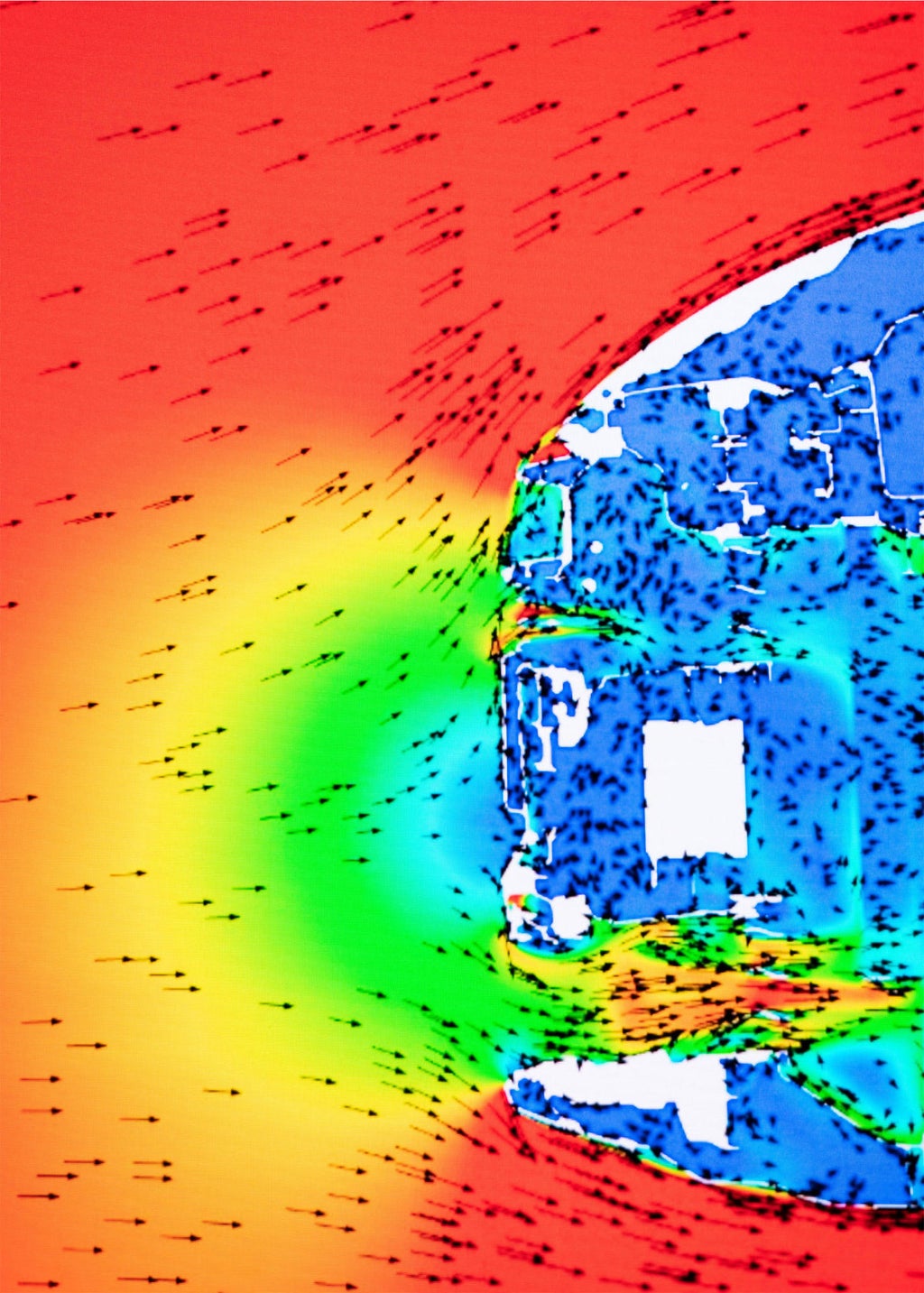
In cars, aerodynamics are all about how the airflow decelerates and mixes encounters an obstacle. The trick is to get the air to adapt itself perfectly to the shape of the vehicle and channel it around or through the car (red = fast, blue = slow).

Dr. Moni Islam has worked for Audi since 2001. After holding various positions in the Audi Group, the Canadian took over responsibility for aerodynamics/aeroacoustics development in 2012.
In cars, aerodynamics are all about how the airflow decelerates and mixes encounters an obstacle. The trick is to get the air to adapt itself perfectly to the shape of the vehicle and channel it around or through the car (red = fast, blue = slow).
Dr. Moni Islam has worked for Audi since 2001. After holding various positions in the Audi Group, the Canadian took over responsibility for aerodynamics/aeroacoustics development in 2012.
The electric car concept is a windfall for aerodynamics
“We shouldn’t forget, however, that when it comes to designing efficient aerodynamics, electric vehicles offer distinct advantages. For instance, it’s only thanks to the battery and dispensing with an exhaust system that we were able to create an enclosed and very smooth underfloor from nose to tail. There was a lot of back and forth with our colleagues in chassis development to make sure all the main axle components remain concealed beneath underfloor panels. Everything—including tunnel, fuel tank and exhaust system—that’s responsible for air turbulence around cars with internal combustion engines no longer exists in the same form on electric vehicles. For aerodynamics, this is a tremendous plus. What’s more, an electric motor is much more efficient than a combustion engine. It not only releases less heat into the environment but does not require as much cooling nearly as often. Consequently, we are able to develop thermal management concepts that are beneficial to aerodynamics. The active inlet louvers on our Audi e-tron models’ Singleframe grilles are a case in point—and a pivotal aerodynamic measure at the front end. An electronically operated louver system on each of the two air inlets can be automatically opened or closed, depending on the degree of cooling the vehicle requires. We aerodynamicists like to say that the louvers should always remain closed so that no air flows through the car and causes losses. Instead, the air should flow over and under the vehicle. But the control system also has to respond to other needs, such as when occupants want to climatize the interior. That’s when the louvers open. Despite that, our highly intelligent thermal management ensures that the louvers remain shut for most of the driving cycle, thus lowering the cd value.”
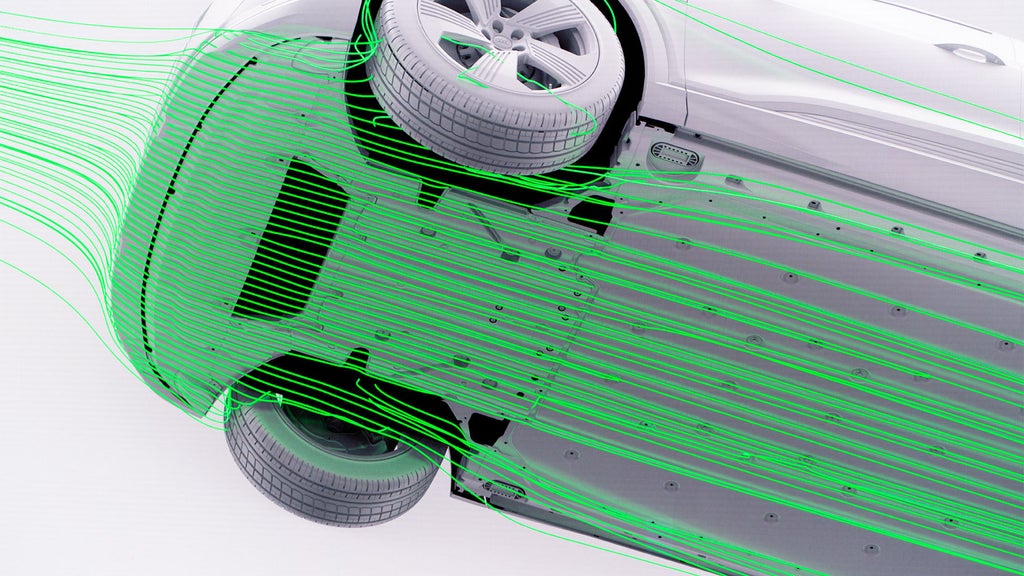
“I want fast-flowing, undisturbed airflow around a car.
“We often think of the drag coefficient as defining how aerodynamic a shape is. Of course, we’re always chasing a better cd value for our vehicles as we develop successive models. With its virtual exterior mirrors, our Audi e-tron has a cd value of 0.27—one of the best on the market for the SUV segment. Many of the currently available SUVs have higher values. That’s why we’re particularly proud of having scored such an outstanding value on a full-blooded SUV. Thanks to its basic streamlined silhouette, the Audi e-tron Sportback even goes one better with a drag coefficient of just 0.25.
So is there a limit to how far we can reduce the cd value? My personal take is that designing a production car that is both a practical workaday vehicle and attractive to customers with a drag coefficient of under 0.20 won’t be possible for the foreseeable future. Ultimately, automotive engineering is constrained by the laws of physics. Nature abounds with inspiring examples of optimum fluid flow. Unsurprisingly, millions of years of evolution have resulted in beautiful case studies of bodies shaped to move through air or water with the least resistance. Studies record penguins as having a cd value of 0.07, which can at times drop even further thanks to special surface effects and dynamic modifications to their body form during movement. For our purposes in vehicle development, however, we can only harness these natural phenomena to a very limited extent in practice. After all, a car functions differently than a penguin. And even if aerodynamicists dream of a vehicle that’s basically shaped like a shark, the reality is that in our work form follows function—which means it’s all about optimization. And let’s not forget: It’s our customers’ needs that define function. If the customer wants to be able to make the most of the trunk space, we can’t go indiscriminately lowering the roof and making the tail narrower—even if it improves the aerodynamics.”
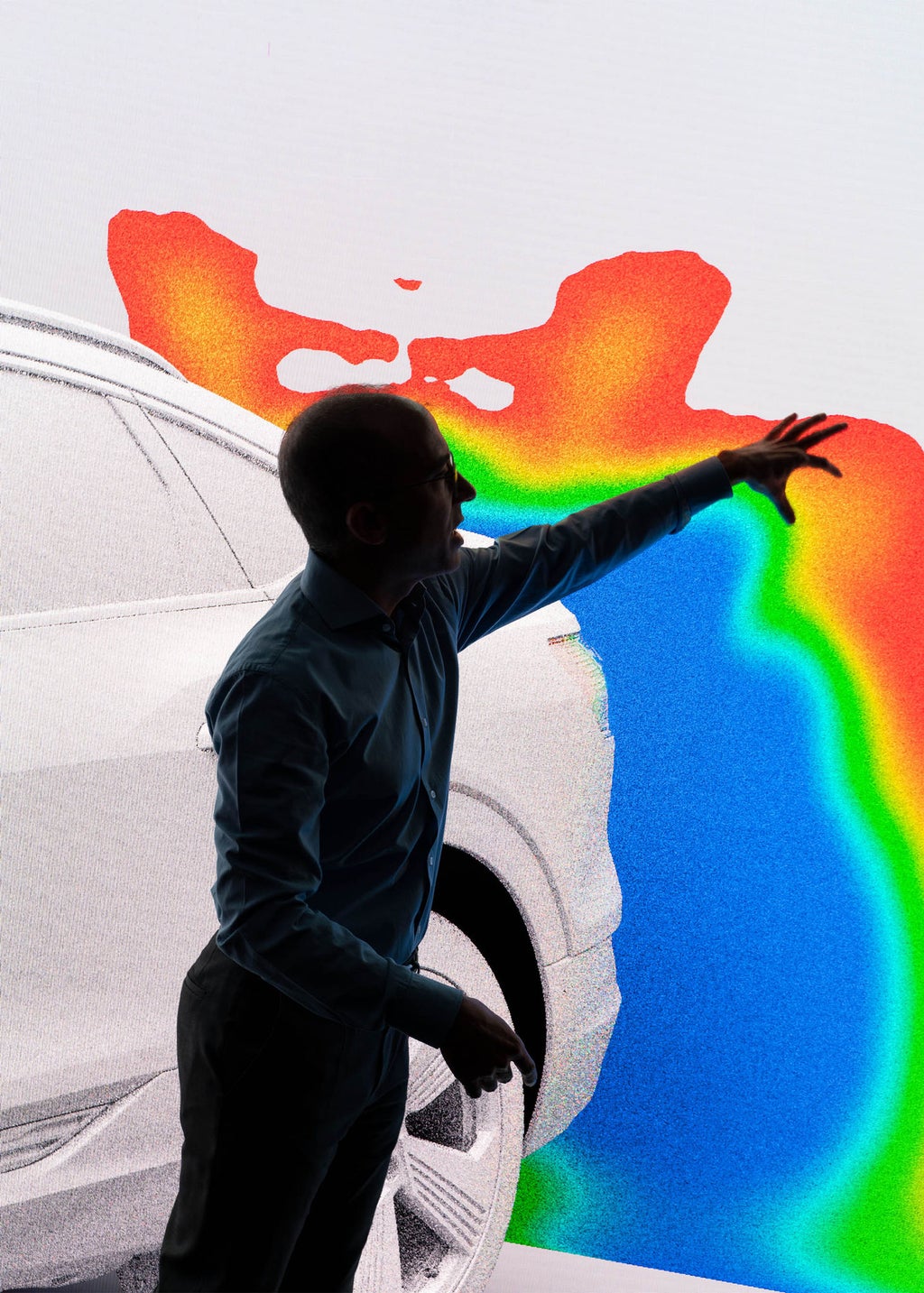
The pattern of airflow at the rear of the vehicle provides an indication of how the drag coefficient can be reduced.
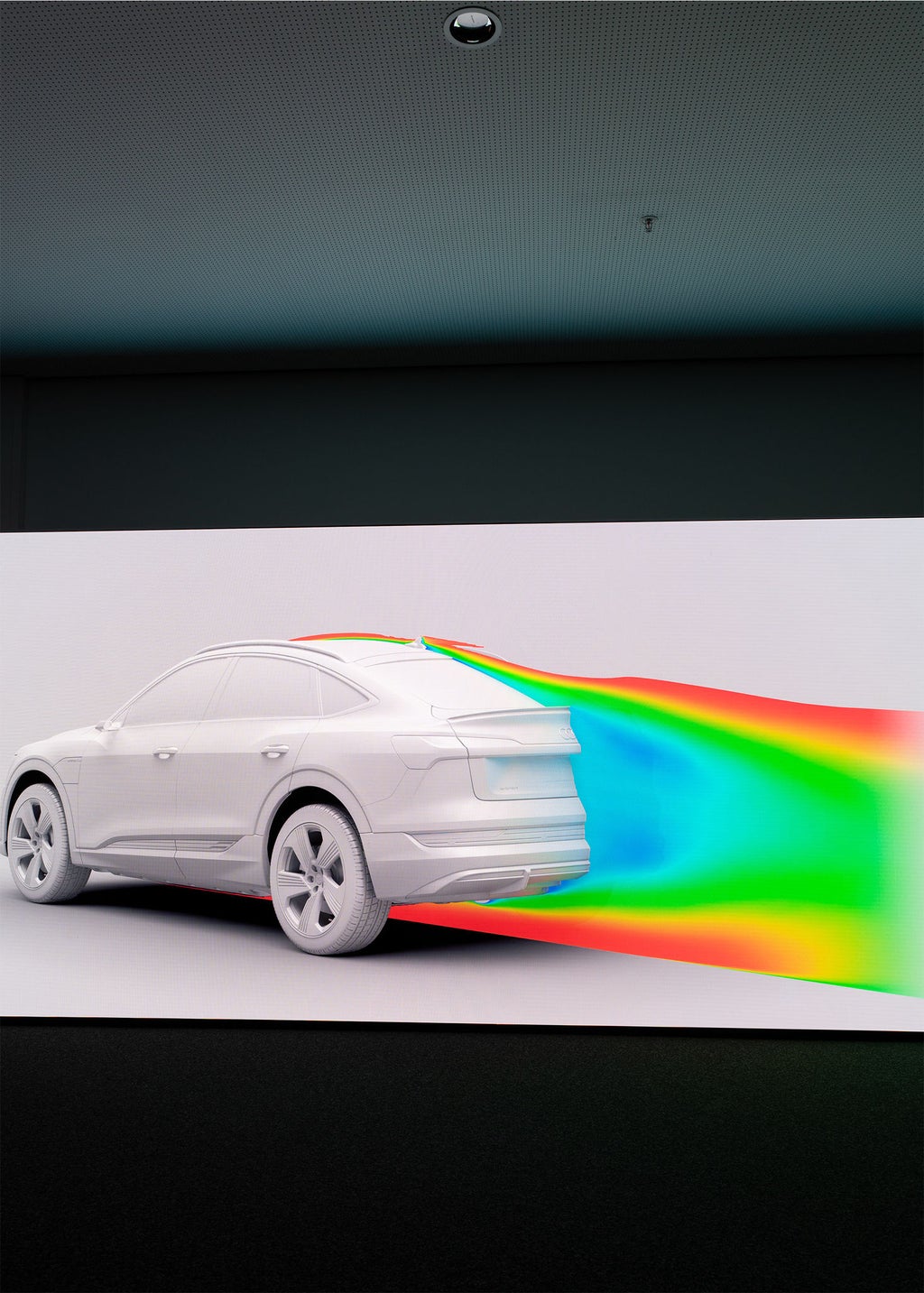
The deflected flow from above and below the vehicle are brought together at the rear of the car in what is known as the wake. This should be as compact and as orderly as possible.
The pattern of airflow at the rear of the vehicle provides an indication of how the drag coefficient can be reduced.
The deflected flow from above and below the vehicle are brought together at the rear of the car in what is known as the wake. This should be as compact and as orderly as possible.
Aerodynamic efficiency in detail
“One of our goals as aerodynamicists is to come up with innovative technical details that give the designers greater scope for creativity. This is done best when we collaborate in solving specific issues. When developing a vehicle’s aerodynamic details, we work from front to rear. After all, if we make a mistake with the airflow at the front, we usually can’t correct it again at the rear.”
Air Curtains
“Air arrives at the front nose of the vehicle thereafter passing above, below and along its sides. Ensuring it flows as smoothly as possible along the sides is an art unto itself. The short overhangs that our designers use to make electric vehicles so attractive pose a really big challenge to us aerodynamicists. They leave us with very little space to deflect the air along the sides after it hits the front at high speed. That’s why we work with air curtains at the side of the car’s nose. These air inlets are like vanes that basically catch the air at the front, quickly guiding it inward and keeping it close to the vehicle body, before channeling it into the wheel arch. If we didn’t have these air curtains, the vehicle would offer a wider surface for the air, which would increase the drag coefficient.”

A-pillar and exterior mirrors
“It might sound trivial but we can use the water management finisher on the A-pillar to smoothly form the surface and greatly optimize the flow from the front along the arc of the A-pillar. If we didn’t do this, it would result in substantial aerodynamic losses. When the airflow then interacts with the exterior mirror. This is a true challenge in aerodynamic terms. A conventional exterior mirror greatly displaces the oncoming flow and influences the airflow until far behind the vehicle. That’s why I’m incredibly pleased that we offer virtual exterior mirrors as an option on our Audi e-tron models. The WLTP cycle shows that their influence on the drag coefficient improves the range by the equivalent of around 2.5 kilometers compared with conventional exterior mirrors. This improvement is even more pronounced on country roads and highways.
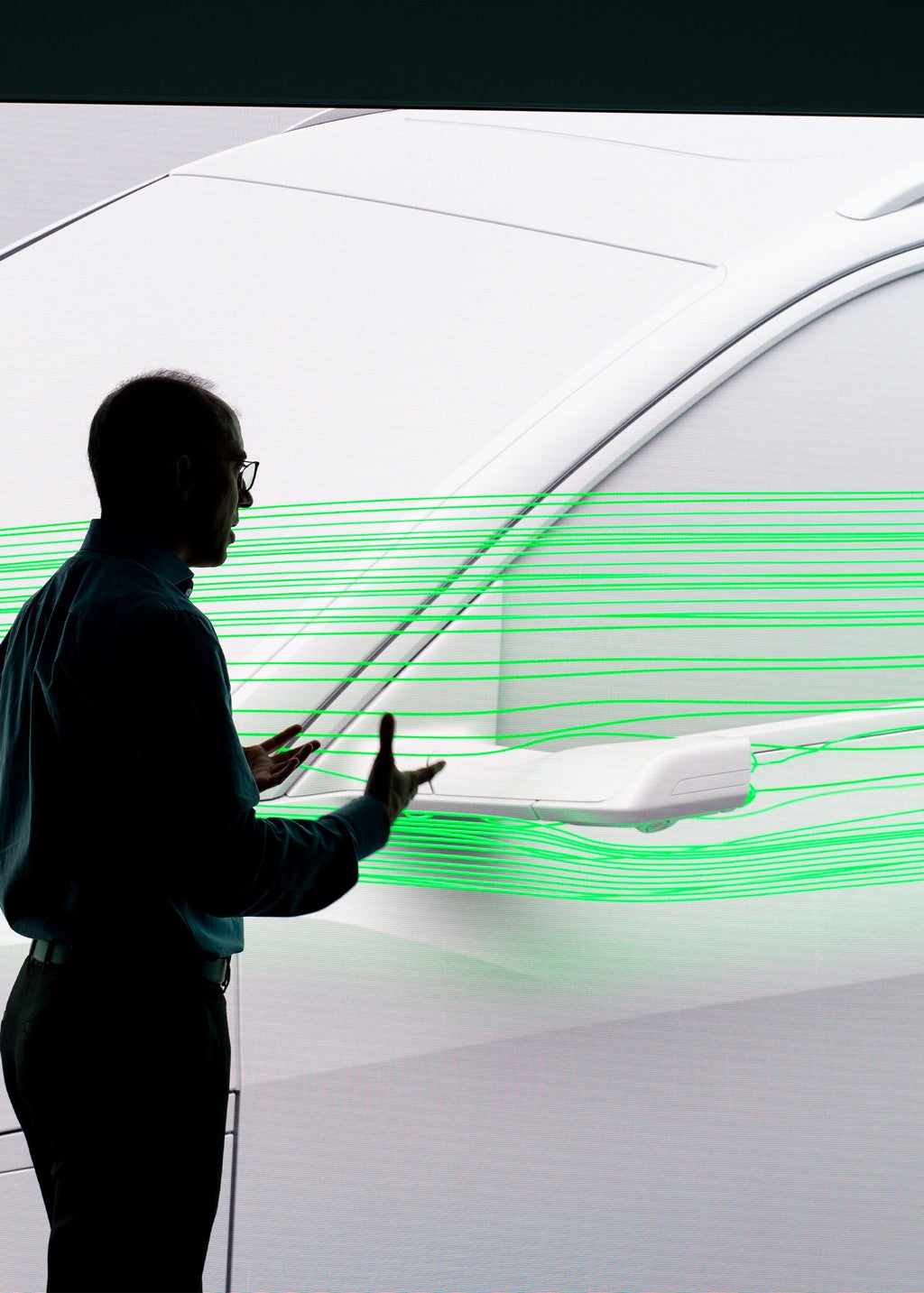
The optional virtual exterior mirrors on the Audi e-tron are very aerodynamic. The WLTP cycle shows that their influence on the drag coefficient improves range by the equivalent of around 2.5 kilometers compared with conventional exterior mirrors.

The aerodynamicists used various visualization methods to analyze the strength of the vortex in the airflow.
The optional virtual exterior mirrors on the Audi e-tron are very aerodynamic. The WLTP cycle shows that their influence on the drag coefficient improves range by the equivalent of around 2.5 kilometers compared with conventional exterior mirrors.
The aerodynamicists used various visualization methods to analyze the strength of the vortex in the airflow.
Tail and rear lights
“Our Audi designers love making a nice curved transition from the side to the rear of the vehicle. However, that’s a real challenge in aerodynamic terms because the air current doesn’t really know where it should separate. “Curved” always results in greater instability. Sometimes the airflow separates in one place, sometimes in another, which results in poor aerodynamics. But, of course, we can’t design an Audi with sharp-edged tail. Instead, we integrate the edges needed to ensure a clean break in the air flow into the rear lights—they follow the same contours as the interior graphics of the lights. This maintains the harmonious appearance of the outer skin and avoids unpleasant refraction of the light. These separation edges on the rear lights are a perfect example of how we work with the designers to optimize innovations on a model in the wind tunnel.”
Rear spoiler and diffuser
“I always tell the designers to make the front of the vehicle round and the rear angular. Unfortunately, they usually do it the other way around—but for us aerodynamicists, the rear is the most important zone. It’s behind the vehicle that an area of low pressure forms. This negative pressure sucks the car backward, thus creating resistance. Our job is to keep the area of negative pressure at the rear of the vehicle as small and compact as we can. So we try to design all the features at the rear to be as narrow and as small as possible: a narrow track width, recessed wheels, a slim luggage compartment. And we use rear or roof spoilers to deflect the airflow in such a way that they meet symmetrically and at the same height behind the vehicle after passing above and below it. That’s why even one spoiler with a relatively small lip can have a really positive effect on the drag coefficient. It corrects the direction of downstream flow and keeps the wake boundaries as parallel as possible so that they join up as close to the rear of the vehicle as we can get them. We fit components near the diffuser to perform the same function on the underbody. On the Audi e-tron, we’re even using a small spoiler on the spare wheel well underneath the car to ensure that the air is deflected to the exact same point behind the vehicle where the airflow comes down off the roof.”

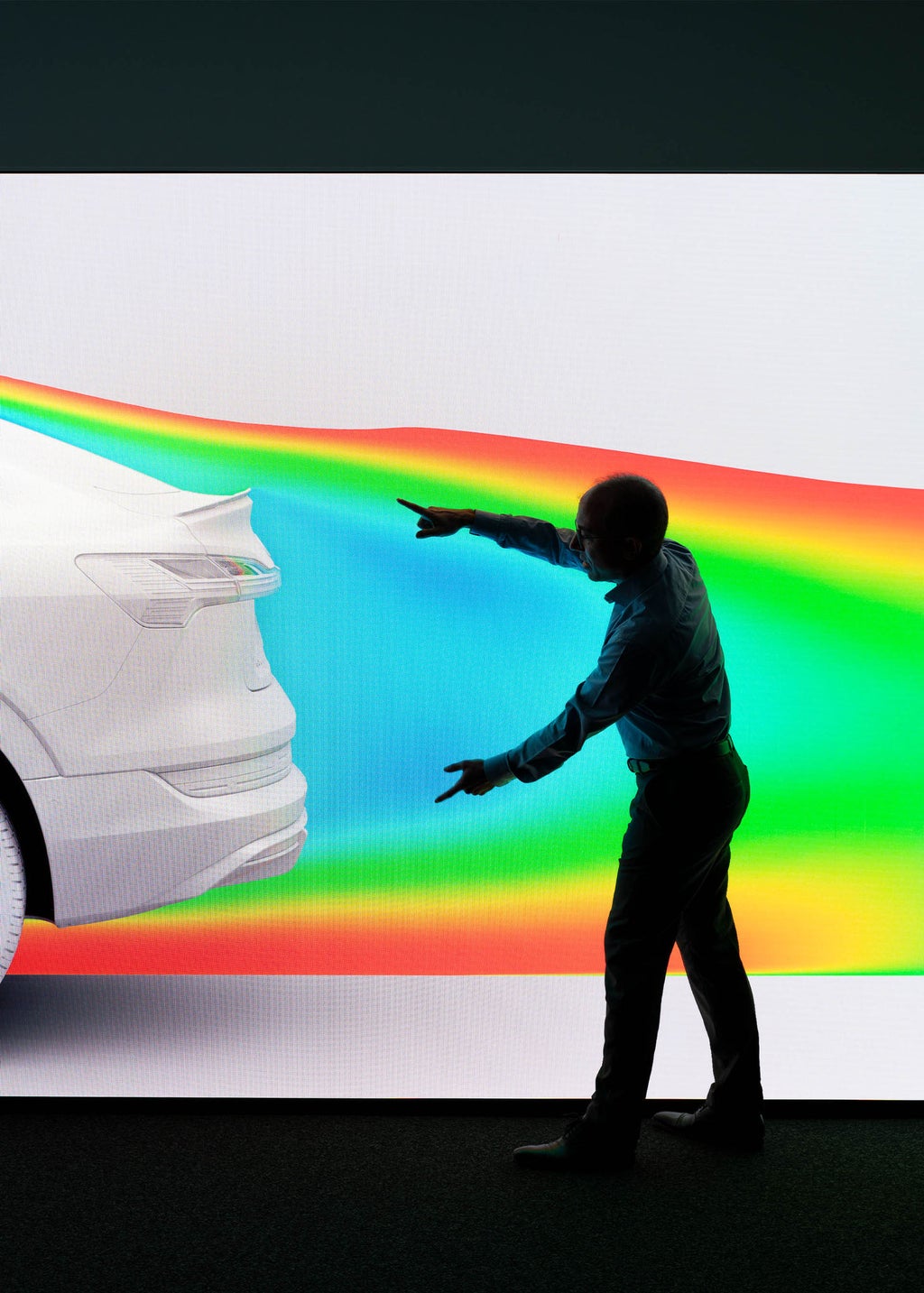
Even tiny details matter
“One example: In a new Audi e-tron model being launched in 2021, there’s a seal in the joint between the side panel frame and the tailgate. Just this seal produces an improvement of five thousandths in the drag coefficient. You might think that it’s just a small gap without this seal. But the pressure ratios between the side and the rear of the car are so extreme that air is sucked into the joint and instantly results in losses. By contrast, using this seal improves the drag coefficient by five thousandths. In the WLTP cycle, this adds around three kilometers to the range. So you see, even the tiniest details will make all the difference going forward.”


